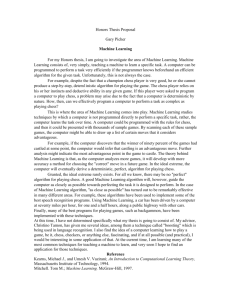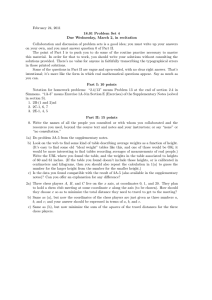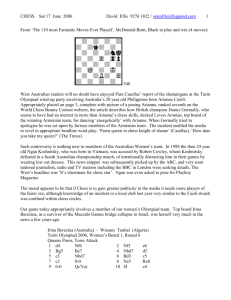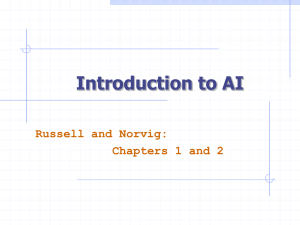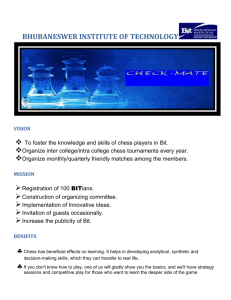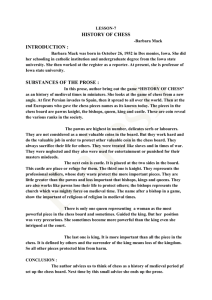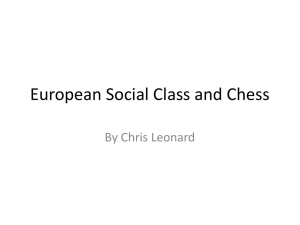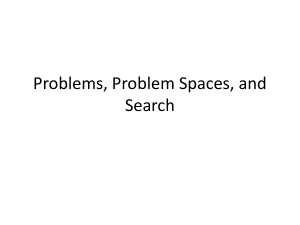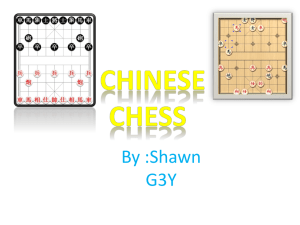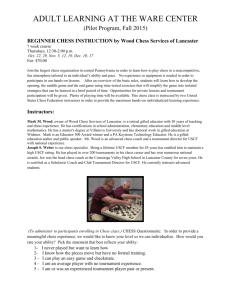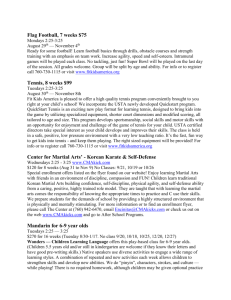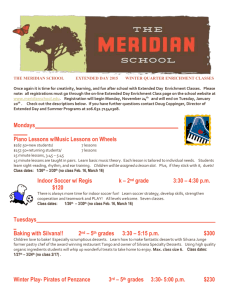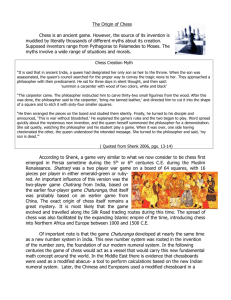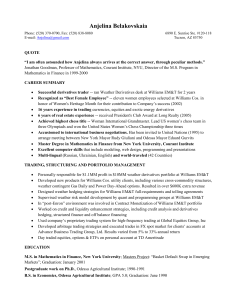Your Move: The Effect of Chess on Math Test Scores
advertisement
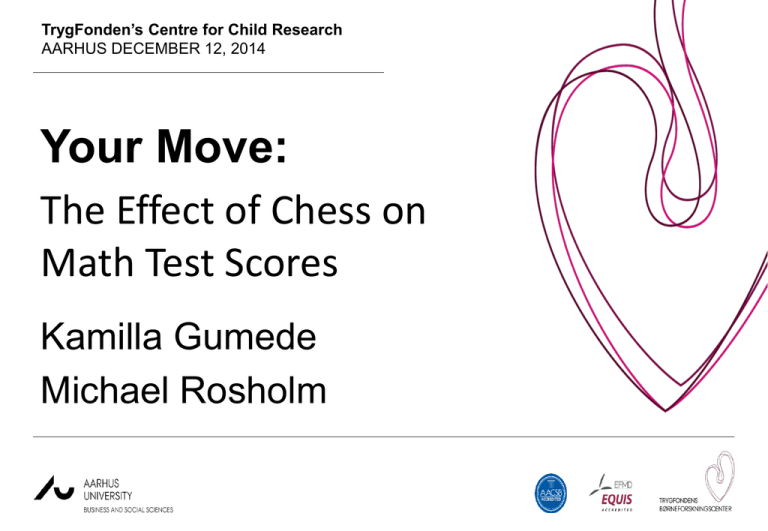
TrygFonden’s Centre for Child Research AARHUS DECEMBER 12, 2014 Your Move: The Effect of Chess on Math Test Scores Kamilla Gumede Michael Rosholm Outline -very preliminary, comments welcome 1. 2. 3. 4. 5. 6. 7. Intro: Background, Aim Existing Evidence The Intervention Data Methodology Results Conclusion Intro: Background • Costs of primary and lower secondary schooling in Denmark are among the highest in OECD • Yet, looking at cross-country data from the PISA studies, Denmark is always ‘average’ in OECD • Shift in focus from cognitive skills towards personality/behavioral factors and lack of selfcontrol/grit/conscientiousness as explanations of school failure Intro: Background • Teaching chess may affect cognitive skills (fluid intelligence) • directly • indirectly through non-cognitive skill formation Intro: Aim Aim: Design intervention to help children improve in school, specifically in mathematics, through teaching chess Think of the present study as a pilot study preparing for a larger scale randomized trial. • As such, it is severely underpowered • Nevertheless, interesting results emerge Existing Evidence (Gobet & Campitallei 2006; Bart, 2014; Boruch, 2011; Berkman, 2004; and many others) Chess is a sequential game, where the players make moves in turn with white and black pieces on the chess board with the aim of capturing the opponent’s king Very complex • • • • • • calculation and planning ahead the ability to concentrate memorizing sequences of moves and resulting positions rewards the ability to exert patience and self-control a set of rules of conduct may directly increase intelligence and problem solving abilities Existing Evidence • Trinchero (2013): Impact of chess instruction on PISA math test scores. Non-randomized data on children aged 8-10 in Italy. Chess instruction in school improves problem solving abilities • Boruch (2011): Only sufficiently powered RCT to date. 33 Italian schools, 30 hours of chess instruction, 3rd grade classes. Chess instruction increases math achievement by a third of a standard deviation. Foreign born pupils have better impacts. The Intervention • • • • • • • Five schools in the City of Aarhus, 1st to 3rd grade Starting in January 2013 and ending mid October 2013 1st-3rd grade classes participate in the study as either treated or control classes. No random allocation… however, almost always ‘A’ class is control and the rest is treated. Students in treated classes have one weekly math lecture replaced by a weekly chess lecture • NOTE: Control classes have more maths! One teacher doing all the teaching A book developed by Dansk Skoleskak: SKAK+MAT was used The intervention Figure 1. A typical chess exercise from the book used for chess instruction Accompanying text: “How many pieces can the knight take? Write your answer on the line below” Data Pre- and post math tests developed by City of Aarhus • Calculation • Problem solving • Pattern recognition Merged with register based info at TrygFondens Centre for Child Research Variable Standardized pre-intervention test-score Boy Girl Age 1st or 2nd generation immigrant Days of school absence 2012 Grade 1 Grade 2 Grade 3 # siblings Age of mother Mother lower secondary school Mother highschool Mother vocational education Mother short academic education Mother medium academic education Mother masters education or more Mother’s average ann. earnings past 3 years, DKK Mother not working 2011 Father present Age of father Father lower secondary school Father highschool Father vocational education Father short academic education Father medium academic education Father masters education or more Father’s average ann. earnings past 3 years, DKK Father not working 2011 N Treatment group Comparison group 0.00 0.54 0.46 9.57 0.28 9.21 0.19 0.45 0.36 1.46 40.53 0.42 0.07 0.27 0.05 0.07 0.11 195,276 0,29 0.79 43.28 0.19 0.05 0.30 0.08 0.14 0.17 278,564 0.19 323 0.05 0.50 0.50 9.45 0.25 9.94 0.31 0.33 0.36 1.53 40.42 0.41 0.08 0.22 0.06 0.08 0.14 188,578 0,30 0.76 42.28 0.15 0.04 0.30 0.10 0.13 0.18 284,405 0.20 159 Data 0 .1 .2 .3 .4 Kernel density estimate, change in testscores -4 -2 0 diffstdscore Treatment Comparison kernel = epanechnikov, bandwidth = 0.2642 2 4 Methodology Level model with control for pre-test scores, child’s characteristics, parental characeteristics, and school fixed effects 𝑌𝑖1 = 𝜇 + 𝛼𝑌𝑖0 + 𝛾𝐷𝑖 + 𝛽𝑋𝑖0 + 𝛿𝑆𝑖 + 𝜀𝑖 (1) ‘Learning’ model, change in the test score is explained by the same variables 𝑌𝑖1 − 𝑌𝑖0 = 𝜏 + 𝜃𝐷𝑖 + 𝜗𝑋𝑖0 + 𝜋𝑆𝑖 + 𝜌𝑖 (2) + D-i-D PS mathching (Heckman, Ichimura, Smith, Todd, 1998) Results Table 3. Estimation results, change in standardized test-scores Model 2: Only chess dummy 3: 2+child and school characteristics 4: 3+mother’s and father’s characteristics Impact estimate 0.18 Standard error 0.09 R-squared 0.01 0.16 0.09 0.04 0.17 0.09 0.08 Results summarized • Positive effect for boys (0.22) but NS for girls • Positive effect for native Danes (0.22) but not for 1st or 2nd generation immigrants • No interactions significant across grades, pre-intervention test scores, or morther’s educational attainment • Positive effects on pattern recognition (~fluid intelligence) No impact on calculation or problem solving • No impact on school absence after program (during?) Conclusion Are the impacts large? Let’s do the RCT! Then we’ll conclude

